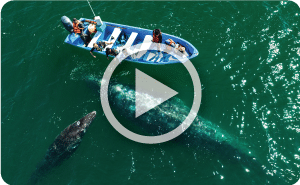We had initially talked about it as requests were coming up to find mobulas and orcas, and we decided to go for them…
I came to Baja 20 years ago working as a dive guide and fell in love with the Sea of Cortez, it kind of became my base, even if I worked around multiple countries as a dive guide.
I started here in Sea of Cortez and around La Paz and am now back with a different target then the normal dive sites. People have become crazy about orcas and mobulas. Before that, sightings were kind of a “by catch” on the way on the dive site and it was cool. But this time they are the main target.
And it is not as easy all the time, as we thought.
We knew getting the orcas would be more difficult. During our trip we had been just some hours behind every time the orcas had been sighted. We had been going up and down the coast having a 30 somewhat RHIB (Rigid Hull Inflatable Boat) with twin 250 hp. And a good friend with a micro floating plane as a spotter three of our six days, that was a great help.
Now on our fifth day we finally managed to find the big schooling mobulas. The mobula munkiana, a very small one reaching to a meter maximum between the wing tips, with a kind of brownish to almost a golden color. My name for them is “popcorn”, as they just pop up above the water, one then several, with splashes as they belly flop down, like someone told them you are a bird! You can fly!
I thought it would be easy as we kind of see them all time at this time of the year, but it took five days!! We saw the bigger ones a lot, the bent fin mobula (mobula thurstoni), and snorkeled with them as well, but they don’t gather in thousands like what we have around us right now as I am writing. Our pilot friend estimated the group to be a 5,000+ squadron of mobulas!
So, the damn orcas…we knew this would not be easy. But we are still not giving up.
We have seen:
*Silky sharks (maybe as well Galapagos)
*Striped marlin (the ocean’s fastest fish)
*Common dolphins in hundreds
*Spinner dolphins
*Spotted dolphins
*Bottlenose dolphins
*Minke whale
*Humpback whale
*Brights whale
*Maybe a fin whale (hard to say)
*And the biggest guy: the blue whale!
*I forgot about a 11-meter pregnant whale shark we helped whale shark researcher Deni Ramirez put a satellite mark on. We found her with out air support.
So, we can’t say we have seen nothing.
I was surprised we have seen so many whales and up so close. The blue whale came into us! First, just in front of the bow, and the second time it came up behind us and just a couple of meters alongside the RHIB; just under the surface. That was a sight! The head freckles it has makes it easier to ID a blue whale, and its wide and slender fin is totally different to the humpback or a sperm whale. As we slowly approach, we see that the whale approaches us too, like they were curious and wanting to see what we where.
This trip is true exploration and us, as well as crew, are learning a lot as we are starting to target these animals. It requires a lot of patience from both guests and staff, and concentration from sunrise to sunset, scanning the ocean. And even if we don’t reach our main target all time, we see a lot that we never mentioned about this trip.
I am going out now for the mobulas, it’s about 5 pm, guests have had a rest and we hope the mobulas are rising up closer to the surface in the late afternoon to evening.
PS. That evening we snorkeled with thousands of them mobulas spending non-stop two hours with them in water and also topside taking photos of them jumping. It was a real show! And real fun!
– Guide Sten (Vikingo ) Johansson, the Sea of Cortez









